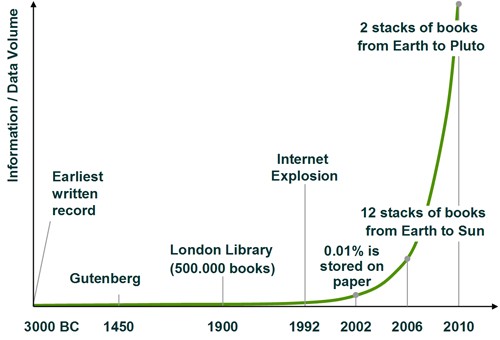We are living in a time of information overload. As communicators, we now have to work harder than ever before to make our messages stand out. Why? Because we’ve got loads of competition.
Check out this graphic from Towards Data Science which shows the way information has boomed throughout history.

So when we write or speak or produce, our message has to make it through all that noise. Here are 4 ways you can battle information overload and get your message across.
1. Use Powerful Graphics
The importance of imagery and visualization can’t be overstated. We live in a world that has shifted from using primarily words to a world that uses words accompanied by visuals. Dr. Lynell Burmark, author of Visual Literacy: Learn to See, See to Learn says that “unless our words, concepts, ideas are hooked onto an image, they will go in one ear, sail through the brain, and go out the other ear. Words are processed by our short-term memory . . . Images, on the other hand, go directly into long-term memory where they are indelibly etched.” When developing your content, give special attention to how graphics can help your message stand out.
2. Tell Great Stories
We naturally process information in story form, and we use narratives to make sense of the world. Researchers Fritz Heider and Marianne Simmel discovered how powerful our pull toward stories is in 1944. They showed 114 participants a short video in which a circle and 2 triangles moved in and out of a box. They then asked the participants to explain what they had just seen. Of those 114 participants, 111 of them (yes, all but 3) created a story to explain the movements and motives of the shapes. Their research reminds us that if want our message to stand out, but also to make sense and stick, we often need to put it in narrative form.
3. Connect Emotionally
Emotions are an effective way to cut through the clutter and noise of all of the information that we encounter. Dr. Shahram Heshmat, Associate Professor at the University of Illinois at Springfield says, “emotion acts like a highlighter pen that emphasizes certain aspects of experiences to make them more memorable . . . Emotionally charged events are remembered better than those of neutral events.” The same is true for information. Messages that are emotionally charged are remembered better. Try to think back on what you learned in elementary school. Chances are, you won’t remember much of anything. The information we do remember usually has a feeling attached to it—it was somehow funny or disturbing or particularly useful to us. When you create a message that helps your audience feel, you also help them learn and remember.
4. Tap into Novelty
In a world where there is lots of the same kind of information, we crave things that are different and new. Steve Jobs understood the power of novelty. One reason he was such an amazing speaker was that he didn’t put himself into some public speaking box. Instead, he challenged expectations and broke down barriers to create his own set of rules for delivering content and engaging his audience. This involved things like making a phone call while on stage or getting really excited about his own product. If you want to stand out, don’t do the same thing as everyone else, the same way as everyone else. Find your own style and embrace it.
When you use graphics, stories, emotional appeals, and novelty, you can win the war of information overload. You can develop messages that stand out, that break through the noise, and that reach your audience no matter how much competition you are up against.
Need help developing, designing, or delivering a presentation that stands out? We’re here to help.